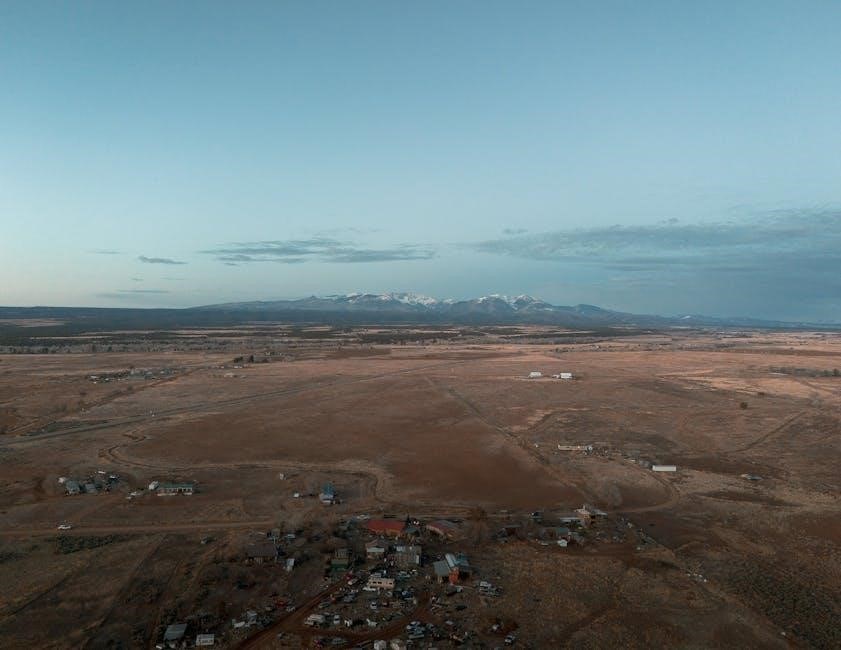Cloud formation and rain are critical components of the Earth’s water cycle, sustaining life and regulating climate. Clouds form through condensation and nucleation, while rain results from precipitation processes. Understanding these phenomena is essential for addressing environmental challenges and managing water resources effectively.
Definition and Importance of Clouds in the Water Cycle
Clouds are visible masses of water droplets or ice crystals suspended in the atmosphere, forming through condensation and nucleation. They play a vital role in the water cycle by storing and transporting water, ultimately leading to precipitation. Clouds regulate Earth’s climate by reflecting sunlight and insulating the planet, maintaining temperature balance. Their formation and distribution influence weather patterns, making them essential for sustaining life, supporting ecosystems, and enabling agriculture. Understanding clouds is crucial for managing water resources and predicting weather phenomena.

Processes Leading to Cloud Formation
Clouds form primarily through the cooling of air, which reaches saturation, leading to condensation and nucleation. These processes initiate the transformation of water vapor into visible droplets or crystals.
Condensation and Nucleation
Condensation occurs when water vapor in the air cools and transforms into liquid droplets or ice crystals. This process is essential for cloud formation and requires nucleation sites, such as dust particles or salt crystals, to initiate. Nucleation allows water molecules to cluster, forming visible droplets. When air reaches its dew point, condensation accelerates, leading to the development of clouds. These processes are fundamental for precipitation, as they lay the groundwork for droplets to grow and eventually fall as rain or other forms of precipitation. Nucleation sites enhance the efficiency of this transformation, making cloud formation more likely.
Freezing and Sublimation Processes
Freezing occurs when supercooled water droplets in clouds freeze into ice crystals, even below 0°C. This process is vital for precipitation, as ice crystals grow by accreting more moisture, becoming heavy and falling as rain, sleet, or hail. Sublimation, the direct transition of water vapor to ice, also plays a role, especially in high-altitude clouds. These processes are crucial for forming precipitation, particularly in cold climates, and influence the type and intensity of rainfall. They are essential for understanding weather patterns and predicting storms. Both processes significantly impact global water distribution and climate regulation.
Saturation and Supersaturation in the Atmosphere
Saturation occurs when air holds its maximum water vapor content, typically at 100% humidity, leading to condensation. Supersaturation happens when air exceeds this capacity, often due to cooling or the presence of condensation nuclei. These states are critical for cloud formation, as supersaturation allows water droplets to grow rapidly. Saturation and supersaturation determine cloud density and precipitation potential, influencing rainfall intensity and duration. Understanding these processes is key to predicting weather patterns and managing water resources effectively. They play a vital role in the Earth’s hydrological cycle and climate regulation.
Types of Clouds and Their Role in Precipitation
Clouds are classified into cumuliform, stratiform, and cirriform types, each influencing precipitation differently. Cumuliform clouds produce heavy, localized rain, while stratiform clouds generate steady, widespread rainfall. Cirriform clouds, high and thin, are linked to light precipitation or snow.
Cumuliform Clouds and Their Characteristics
Cumuliform clouds are dense, towering clouds with vertical growth, often resembling cotton tufts. They form in unstable atmospheres, driven by strong updrafts, and can develop into towering cumulus or cumulonimbus clouds. These clouds are associated with heavy precipitation, thunderstorms, and even tornadoes due to their intense updrafts and downdrafts. Cumuliform clouds play a significant role in severe weather events, producing heavy rain, hail, and lightning. While they are linked to turbulent conditions, smaller cumuliform clouds, like fair-weather cumulus, indicate stable atmospheric conditions and light precipitation.
Stratiform Clouds and Their Impact on Rainfall
Stratiform clouds are uniform, flat, and layered, often covering vast areas of the sky. They typically form in stable atmospheric conditions, such as temperature inversions or frontal systems, leading to steady, widespread rainfall. These clouds produce light to moderate precipitation over long durations, making them crucial for sustained water supply in regions. Stratiform clouds, including stratus and nimbostratus, are associated with consistent rain patterns, which are vital for agriculture but can also cause flooding if prolonged. Their layered structure prevents vertical growth, distinguishing them from cumuliform clouds.
Cirriform Clouds and Their Relation to High-Level Precipitation
Cirriform clouds are high-level clouds composed of ice crystals, appearing as thin, wispy lines or tufts in the upper atmosphere. They form when water vapor freezes at altitudes above 6,500 meters, often indicating fair weather but sometimes preceding storms. Cirrus clouds are associated with cold fronts or tropical cyclones, playing a role in high-level precipitation. They can evolve into cumulonimbus clouds, leading to intense rainfall. Cirriform clouds regulate Earth’s temperature by reflecting sunlight and trapping heat, influencing global climate patterns and weather systems.
Mechanisms of Rainfall Formation
Rainfall forms through coalescence and accretion, where millions of cloud droplets merge, growing large enough to fall as rain, with droplets reaching up to 6 mm in diameter during heavy downpours.

Coalescence Process in Cloud Droplets
The coalescence process involves the merging of water droplets in clouds, driven by collisions. As droplets grow, their fall speeds increase, leading to further collisions and larger droplets. This process is enhanced by high humidity and updrafts, which sustain droplet growth until they become too heavy to remain suspended. Coalescence is most effective in cumuliform clouds, where turbulent updrafts facilitate frequent droplet interactions. Eventually, droplets exceeding 5 mm in diameter fall as rain, completing the coalescence cycle.

Bergeron Process and Ice Nucleation
The Bergeron Process explains how ice crystals grow in clouds at the expense of surrounding water droplets. Ice nucleation occurs when supercooled water freezes onto particles, forming ice crystals. These crystals attract water vapor, which freezes onto them, increasing their size. This process is enhanced in cold clouds, where ice crystals collide and merge, becoming heavy enough to fall as precipitation. Ice nucleation is critical for rainfall in high-level clouds, as it facilitates the transition from small cloud droplets to larger, precipitation-capable ice particles.
Precipitation Enhancement Techniques
Precipitation enhancement techniques, such as cloud seeding, aim to stimulate rainfall or snowfall by introducing substances like silver iodide or salt into clouds. These materials act as ice nuclei, promoting the growth of ice crystals, which eventually become heavy enough to fall as precipitation. This method is often used in regions experiencing drought or water scarcity to augment rainfall. Additionally, seeding can reduce hail damage by breaking up large hailstones into smaller, less destructive particles. These techniques require precise targeting of cloud conditions to ensure effectiveness and minimize environmental impact.

Measurement and Analysis of Clouds and Rainfall
Advanced technologies like radar, satellites, and rain gauges are used to monitor and analyze clouds and rainfall, helping to predict weather patterns and understand precipitation dynamics accurately.
Modern Technologies for Cloud and Precipitation Monitoring
Modern technologies such as satellites, radar systems, and rain gauges provide detailed insights into cloud formation and precipitation patterns. Satellites offer high-resolution imagery, enabling the tracking of cloud movements and precipitation systems. Radar systems, including Doppler radar, allow real-time monitoring of rainfall intensity and storm trajectories. Additionally, cloud-seeding techniques, such as dispersing silver iodide, enhance precipitation in targeted areas. These tools collectively improve weather forecasting, climate modeling, and water resource management, ensuring better preparedness for extreme weather events and sustainable water distribution.

Classification of Rainfall Intensity and Duration
Rainfall is classified based on intensity and duration, with categories ranging from light to extreme. Light rainfall is less than 2.5 mm/h, moderate is 2.5-10 mm/h, heavy is 10-50 mm/h, and very heavy exceeds 50 mm/h. Duration varies from short, lasting under an hour, to prolonged, spanning several hours or days; Extreme events, like monsoons, may persist for weeks. This classification aids in meteorological forecasting, hydrological planning, and understanding environmental impacts, ensuring effective management of water resources and preparedness for weather-related events.

Environmental Impact of Clouds and Rainfall
Clouds regulate Earth’s climate by absorbing and reflecting sunlight, while rainfall distributes freshwater, sustaining ecosystems and agriculture, making them vital for environmental balance and life support systems.
Role of Clouds in Global Climate Regulation

Clouds play a vital role in regulating Earth’s climate by reflecting sunlight and absorbing heat, influencing global temperature and precipitation patterns. Their formation and distribution impact energy balance, moderating extremes and maintaining atmospheric equilibrium. Clouds act as both insulators and reflectors, affecting weather systems and long-term climate conditions. Their ability to store and release water vapor ensures continuous cycles of evaporation and condensation, essential for sustaining life and stabilizing Earth’s climate. This regulation is crucial for maintaining ecological balance and mitigating extreme weather events.

Effects of Rainfall on Ecosystems and Agriculture
Rainfall is essential for sustaining ecosystems and agriculture, replenishing water sources and promoting plant growth. It maintains soil health, supports biodiversity, and enables crop production, ensuring food security. However, excessive or irregular rainfall can cause flooding, soil erosion, and crop damage, disrupting agricultural productivity. Balanced rainfall patterns are crucial for ecological equilibrium and sustainable farming practices, directly impacting global food systems and environmental stability.
Cloud formation and rainfall are vital for Earth’s hydrological cycle, influencing climate, ecosystems, and agriculture. Understanding these processes is crucial for environmental management and sustainable water resource planning.
Cloud formation and rainfall are essential components of Earth’s water cycle. Clouds form through condensation and nucleation, while rainfall results from processes like coalescence and the Bergeron process. Different cloud types, such as cumuliform, stratiform, and cirriform, play distinct roles in precipitation. These processes are crucial for global climate regulation, ecosystem health, and agriculture. Understanding cloud dynamics aids in predicting weather patterns and managing water resources effectively, highlighting the importance of continued research in this field.